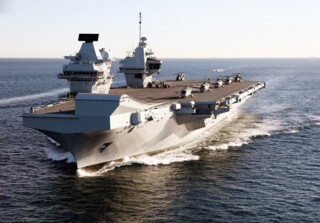On 14 April 1988, right at the end of the Iran-Iraq War, a US navy frigate, Samuel B. Roberts, hit a mine and was badly damaged. Ten of the crew were injured. The US blamed Iran – even though Iraq had been just as active in laying mines – and attacked the Iranian navy, sinking the frigate Sahand and the fast attack craft Joshan. Fifty-six Iranian sailors were killed. The Iranians realised that in any future war with the US they would lose badly, and they rapidly moved to irregular warfare, prioritising mines, shore-based anti-ship missiles, speedboat swarms and mini-submarines. American policy, in response, began with limiting the potential of mines to restrict US operations in the Gulf, and has extended to countering new Iranian developments. The mines remained important, though, and this was where the British came in.
By the time Roberts was attacked, the British navy’s withdrawal from east of Suez – begun in the 1960s – was already in reverse, at least in the Gulf, because of the risk posed to oil and gas supplies during the Iranian Revolution and the wars that followed. A permanent naval presence, the Armilla Patrol, was maintained for many years, boosted by the Iraq War of 2003. More recently, the British naval presence in the Gulf has centred on a squadron of four minehunters. Two years ago, however, the UK established a permanent naval base, HMS Juffair, in Bahrain – the first UK naval base east of Suez in more than four decades. Since last April it has been expanded by the permanent addition of a Type-23 frigate (currently HMS Montrose), designed to track submarines and anti-ship missiles, and a destroyer has also been patrolling the area, supported by two Royal Fleet Auxiliaries.
On its own, this expansion is significant and would increase the navy’s role in any future conflict in the Gulf – say, in an American war against Iran. What is striking, however, is that the British government is explicitly engaged in a more general military return to the Indian Ocean and the Asia Pacific region, described in terms of ‘making Britain great’ in the wake of Brexit. The former defence secretary Gavin Williamson has been a particularly forceful advocate of this approach. In a speech last February, he argued that leaving the EU would allow us ‘to consider how we not only project but maximise our influence around the world in the months and years to come’. This, he argued, is ‘a moment when we must strengthen our global presence, enhance our lethality and increase our mass’. Military power is clearly the key to greatness, and Williamson has recommended further overseas bases in addition to Bahrain and the extension of British sea power to include deployment of a full carrier task group (a fleet consisting of an aircraft carrier and supporting vessels). The aircraft carrier HMS Queen Elizabeth, the largest warship ever built for the British navy, is due to come into service in 2021 if not before; Williamson sees it entering the South China Sea in a matter of years.
If these plans are realised, Britain’s naval prowess will be greater than at any time since the 1950s. Then the navy had at least five large aircraft carriers, including HMS Eagle (1951-72) and HMS Ark Royal (1955-79), and could deploy Scimitar and Buccaneer strike aircraft, which were equipped to carry tactical nuclear weapons. There was even discussion of such weapons being used if a conventional war were to break out east of Suez. As minister of defence, Harold Macmillan told the House of Commons in March 1955 that ‘the power of interdiction upon invading columns by nuclear weapons gives a new aspect altogether to strategy, both in the Middle East and the Far East. It affords a breathing space, an interval, a short but perhaps vital opportunity, for the assembly, during the battle for air supremacy, of larger conventional forces than can normally be stationed in those areas.’
Britain’s carrier fleet was depleted in the 1970s, but the navy cleverly succeeded in acquiring three light carriers of the Invincible class by calling them ‘through-deck cruisers’. Although equipped with the nuclear-capable Sea Harrier jump jets, these were due to be cut in the early Thatcher years, only to be saved by the Falklands War. The Conservatives have always been far more likely to cut military spending than Labour – they don’t have to fear accusations of defeatism and a lack of patriotism. John Major continued the trend in the 1990s even as the navy argued vigorously for two new fleet carriers to replace the three small Invincible-class ships.
This was effected under Tony Blair and Gordon Brown and, after many delays and much cost inflation, the navy now has its two super-carriers, the Queen Elizabeth and Prince of Wales, both equipped with the hugely expensive American F-35 strike aircraft: single-engine planes designed for ground attack and air superiority missions (claiming an enemy’s airspace).* Once the Queen Elizabeth is ready for full-scale operations it will be able to lead a sizeable force anywhere in the world, something the Royal Navy hasn’t been able to do since the postwar period, when there were support bases in Yemen, Singapore and other Commonwealth countries. Secure naval bases are still essential – HMS Juffair is only the first – but warships of the size and power of the Queen Elizabeth can’t easily be contained in the shallow waters of the Gulf. This is where an entirely new base comes in: Duqm in Oman.
Duqm is a major new port city and industrial area on the Arabian Sea coast of Oman, beyond the Strait of Hormuz. It houses a new joint logistics support base capable of berthing the two British aircraft carriers, as well as nuclear-powered attack submarines, frigates, destroyers, auxiliary ships and the rest. A British army desert warfare training centre is also in progress at Duqm, backed by a new UK-Oman Joint Defence Agreement. When Oman’s ruler, Sultan Qaboos, died on 10 January, Prince Charles, Boris Johnson, the current defence secretary, Ben Wallace, and the chief of the armed forces, General Sir Nick Carter, were quick to fly out. The new defence accord is surely the reason. Qaboos had ruled for half a century and was treated as a benign head of state by UK governments and the media – if not by Amnesty International, which has consistently drawn attention to Oman’s poor human rights record and harsh penal code.
With the way cleared to deploy carrier task groups whenever and wherever required, Johnson’s government is set for a greater global role. But there are difficulties ahead. The most pressing is that a warship the size of the Queen Elizabeth needs a lot of protecting, especially in dangerous waters a long way from home. It has to be accompanied by two anti-submarine frigates, two air defence destroyers, a nuclear-powered attack submarine, two tankers and a supply ship. Such a force would denude the Royal Fleet Auxiliary. Deploying a warship in distant waters for months on end requires two backup ships for each one in action: one working up or in transit, and one in refit or repair. The navy simply does not have the numbers.
Currently it has just six destroyers, all of which have been plagued by major engineering problems; only four are fully operational. The Royal Fleet Auxiliary lacks a new ship investment programme and the new Astute submarine force has serious reliability issues. Moreover, the navy has had severe recruitment problems for years and is particularly short of the skilled personnel needed to crew aircraft carriers. There is no chance at all of putting both carriers to sea, fully equipped and crewed, at the same time – just one instance of the difficulties with faulty equipment, major cost overruns and delays that have afflicted the British armed forces. The result is that hardly anyone in defence circles thinks that the carriers will ever conduct major operations without integration into other forces, most likely the US navy.
Quite apart from the government’s failure to recognise, or fund, the necessary adjuncts of such an ambitious undertaking, the security challenges of the future are far more likely to be climate breakdown, mass migration and failing states, for which aircraft carriers, and indeed nuclear weapons, are irrelevant. In the meantime we continue to indulge in delusions of post-imperial grandeur, best summed up some years ago by Clive Ponting when he suggested that the real reason the navy needs an aircraft carrier is so that it has a large enough deck for the Royal Marines Band to beat the retreat at sunset in some tropical port.
Send Letters To:
The Editor
London Review of Books,
28 Little Russell Street
London, WC1A 2HN
letters@lrb.co.uk
Please include name, address, and a telephone number.


